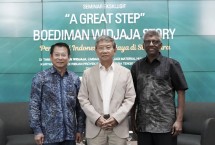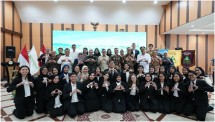When Rice Self-Sufficiency Is Difficult To Achieve
By : Arya Mandala And Aldo Bella Putra | Monday, February 05 2018 - 20:00 IWST

Beras Impor (Foto Dok Industry.co.id)
INDUSTRY.co.id - Jakarta, The condition of the rice market in the country proved unstable. Once spelled out we have been successful self-sufficiency in rice, but the evidence is currently Indonesia still rely on demand in other countries. Rice imports reopened.
In the course of reaching Indonesia as a world food barn, the government still has to struggle to meet the food needs, especially rice, to be obtained by the community at affordable prices.
At the turn of 2017 to 2018 and continuing through the early weeks of 2018, people complained of significant increases in rice prices in various regions.
Whereas previously, in 2016, three food commodities namely rice, onion, and chili have been categorized as commodities have been considered adequate production.
Government policy through the establishment of Trade Ministerial Regulation No. 57 of 2017 on Highest Retail Price (HET) of Rice and Regulation of the Minister of Agriculture (Permentan) No. 31 of 2017 on Quality Classes Rice was not always effective to maintain rice price stability.
The effective regulation valid since September 18, 2017 is untested long time to withstand price fluctuations.
The price of rice reached its highest point in early 2018. In Cipinang Rice Market, medium price of rice in the first week reached between Rp10,500 / kg and Rp11,500 / kg.
This figure is far above the price of rice at the beginning of 2017 which costs around Rp 9,500 / kg.
Not only medium-type rice that experienced price increases. Premium rice also shows price fluctuations.
Mendag Enggartiasto Lukita in the exposure at the Ministry of Trade some time ago said that premium rice reached Rp 13.000 / kg.
Meanwhile, based on data from the National Strategic Food Price Information Center, the average price of medium rice in Jakarta is Rp 14,100 per kilogram, surpassing the Rp 9,450 per kilogram set.
Still in order to maintain price stability, particularly premium rice, the Minister of Trade requires all modern retailers to sell premium rice in accordance with the Highest Retail Price (HET) set by the government.
To ensure no upward price increases, Enggar has made deals with suppliers and distributors not to raise the price of premium rice to the retail stores they supply.
Do not want to take risks, to overcome the scarcity of rice supply that impact on the increase in selling price of rice at the retailer level, the government will import.
But according to Enggar, the rice to be imported is not rice produced domestically, but special rice or premium rice.
Faced with rising rice prices in recent months, after passing a series of market operations, the government decided to open a special import of 500,000 tons of rice originating from Thailand and Vietnam.
Enggar said that rice is exported premium rice but with medium price by appointing Bulog for import.
Inaccurate Production Data?
However, import policies also reap the controversy. Various parties mentioned that the current import policy is not appropriate given the rice production is still sufficient and will soon come during harvest time.
Separately, the Director General of Food Crops of the Ministry of Agriculture, Gatot Irianto, has made sure that the rice production is not reduced and added with the stock in Bulog is still 1 million tons enough until the harvest in February 2018.
Thus Kementan considers the government will not import. If stocks are enough why prices keep bouncing up?
Among the differences of government opinion, agricultural observers Professor of Bogor Agricultural University Dwi Andreas Santoso considers that rice imports late to be done at this time considering the harvest will come soon.
With time-consuming import procedures, it is estimated that imports are ineffective in reducing current price issues. The imports should have been done from July 2017.
According to Dwi's analysis, there is an irregularity from the surplus data of rice stock owned by the Ministry of Agriculture (Kementan) of 17.4 million tons in 2017.
The reasons, Bulog’s capacity can only hold 13 million tons of rice for a year, while the national rice consumption per year is only half of 17.4 million tons.
Rice production data in recent years did increase.
Central Bureau of Statistics (BPS) noted that Indonesia's rice production increased to 75.39 million tons of dried unhulled rice (GKG) throughout 2015.
The realization is 4.55 million tons or 6.42 percent higher than the total production of 2014 of 70.84 million tons.
Based on data from Kementan, rice production in 2016 reached 79.1 million tons, up from 2015 which amounted to 75.4 million tons.
In 2017, it is targeted to reach at least 78 million tons of rice production or equivalent to 45.2 million tons of rice.
The increase in production occurred due to the increase of the harvest area of 0.32 million hectares or 2.31 percent and the increase in productivity of 2.06 quintals per hectare equivalent to 4.01 percent.
Based on data from BPS, the Ministry of Agriculture estimates that Indonesia has a rice surplus of 400 thousand tons in 2018.
With reference to total rice harvest data in December 2017 with 1.1 million hectares planted, its productivity reaches 6 million tons of dry milled grain (GKG) or equivalent to 3 million tons of rice.
The production is expected to meet the national rice consumption requirement for one year of 2.6 million tons.
Thus there is still more stock of 0.4 million tons or 400 thousand tons of rice.
Furthermore, Agricultural Statistics Functional Officer, Data and Information System Center of Ministry of Agriculture, Sri Wahyuni, said that the data of BPS, the export volume of rice consumption during January to October 2017 reached 4,227 percent compared to the same period in 2016.
As is known, the government through the Ministry of Agriculture has targeted Indonesia as World Food Lumbung in 2045.
As a world food barn, Indonesia is expected to be more than just achieving self-sufficiency but also can export overseas.
In addition to rice, the food self-sufficiency program is also aimed at 7 other main food commodities such as onion, chilli, corn, soybeans, sugar, beef, and garlic.
Indonesia's position as a producer of rice in the world should be taken into account.
Indonesia is currently listed as the third largest rice producer in the world with grain production of 70 million tons, with a conversion to rice of around 39 million tons of rice, with an average requirement of 2.67 million tons per month.
But it is realized that the challenge to meet the government's target is not easy. The population of Indonesia also boils down to the large demand of community rice.
If in 2005 rice demand equal to 52.8 million tons of dried unhulled rice (GKG), the demand for rice is predicted to continue to increase to reach 65.9 million tons of GKG until 2025.
Not many know, the rice circulating in various regions in the country, consists of various types.
Based on information from National Standardization Body (BSN), rice is divided into 4 classifications of Indonesian National Standard (SNI) of rice quality, namely premium, medium I, medium II, and medium III.
Some general requirements for SNI for such rice are free of pests and diseases, odor free, odor or other foreign odors, free of mixture of bran and bran, and free of chemicals that endanger consumers.
Read Also
Today's Industry

Rabu, 21 Mei 2025 - 10:09 WIB
Indonesia, Thailand Sign MoU on Health Sector, Focusing on Global Capacity, Collaboration
As a part of President Prabowo Subianto’s official visit to Thailand, both countries signed a Memorandum of Understanding (MoU) on health sector, in an effort to strengthen bilateral cooperation…

Rabu, 21 Mei 2025 - 10:06 WIB
Indonesia, Thailand Deepen Cooperation on Security, Trade, and Regional Stability
resident Prabowo Subianto has reaffirmed Indonesia’s strong commitment to deepening bilateral relations with Thailand during the meeting with Thailand’s Prime Minister Paetongtarn Shinawatra…

Selasa, 20 Mei 2025 - 12:44 WIB
Boediman Widjaja's Technology Ready to be Adopted in Jababeka Industrial Estate (KIJA)
In an exclusive seminar entitled "A Great Step: Boediman Widjaja Story - Going from Indonesia, Thriving in Singapore" held at the President Lounge, Menara Batavia, Boediman Widjaja, Founder…

Jumat, 02 Mei 2025 - 10:46 WIB
Binawan and Government Support Indonesian Nurses in Europe through Scholarships
In the midst of the viral #KaburAjaDulu hashtag as a symbol of the young generation's disappointment with domestic working conditions, Binawan responded with real action: dispatching Indonesian…

Jumat, 28 Maret 2025 - 22:21 WIB
SUNeVision Initiates MEGA IDC Phase Two Development
SUNeVision, the technology arm of Sun Hung Kai Properties (SHKP), today announced the commencement of construction for Phase Two of MEGA IDC in Tseung Kwan O. As Hong Kong's largest data centre…

















News Comment